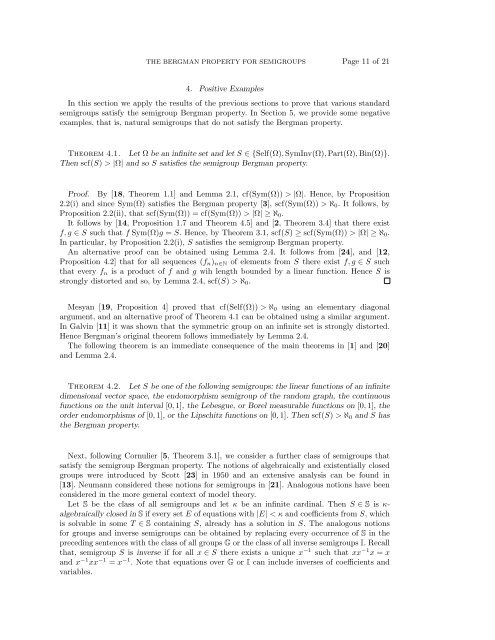The Bergman property for semigroups
The Bergman property for semigroups
The Bergman property for semigroups
You also want an ePaper? Increase the reach of your titles
YUMPU automatically turns print PDFs into web optimized ePapers that Google loves.
THE BERGMAN PROPERTY FOR SEMIGROUPS Page 11 of 21<br />
4. Positive Examples<br />
In this section we apply the results of the previous sections to prove that various standard<br />
<strong>semigroups</strong> satisfy the semigroup <strong>Bergman</strong> <strong>property</strong>. In Section 5, we provide some negative<br />
examples, that is, natural <strong>semigroups</strong> that do not satisfy the <strong>Bergman</strong> <strong>property</strong>.<br />
<strong>The</strong>orem 4.1. Let Ω be an infinite set and let S ∈ {Self(Ω), SymInv(Ω), Part(Ω), Bin(Ω)}.<br />
<strong>The</strong>n scf(S) > |Ω| and so S satisfies the semigroup <strong>Bergman</strong> <strong>property</strong>.<br />
Proof. By [18, <strong>The</strong>orem 1.1] and Lemma 2.1, cf(Sym(Ω)) > |Ω|. Hence, by Proposition<br />
2.2(i) and since Sym(Ω) satisfies the <strong>Bergman</strong> <strong>property</strong> [3], scf(Sym(Ω)) > ℵ 0 . It follows, by<br />
Proposition 2.2(ii), that scf(Sym(Ω)) = cf(Sym(Ω)) > |Ω| ≥ ℵ 0 .<br />
It follows by [14, Proposition 1.7 and <strong>The</strong>orem 4.5] and [2, <strong>The</strong>orem 3.4] that there exist<br />
f, g ∈ S such that f Sym(Ω)g = S. Hence, by <strong>The</strong>orem 3.1, scf(S) ≥ scf(Sym(Ω)) > |Ω| ≥ ℵ 0 .<br />
In particular, by Proposition 2.2(i), S satisfies the semigroup <strong>Bergman</strong> <strong>property</strong>.<br />
An alternative proof can be obtained using Lemma 2.4. It follows from [24], and [12,<br />
Proposition 4.2] that <strong>for</strong> all sequences (f n ) n∈N of elements from S there exist f, g ∈ S such<br />
that every f n is a product of f and g wih length bounded by a linear function. Hence S is<br />
strongly distorted and so, by Lemma 2.4, scf(S) > ℵ 0 .<br />
Mesyan [19, Proposition 4] proved that cf(Self(Ω)) > ℵ 0 using an elementary diagonal<br />
argument, and an alternative proof of <strong>The</strong>orem 4.1 can be obtained using a similar argument.<br />
In Galvin [11] it was shown that the symmetric group on an infinite set is strongly distorted.<br />
Hence <strong>Bergman</strong>’s original theorem follows immediately by Lemma 2.4.<br />
<strong>The</strong> following theorem is an immediate consequence of the main theorems in [1] and [20]<br />
and Lemma 2.4.<br />
<strong>The</strong>orem 4.2. Let S be one of the following <strong>semigroups</strong>: the linear functions of an infinite<br />
dimensional vector space, the endomorphism semigroup of the random graph, the continuous<br />
functions on the unit interval [0, 1], the Lebesgue, or Borel measurable functions on [0, 1], the<br />
order endomorphisms of [0, 1], or the Lipschitz functions on [0, 1]. <strong>The</strong>n scf(S) > ℵ 0 and S has<br />
the <strong>Bergman</strong> <strong>property</strong>.<br />
Next, following Cornulier [5, <strong>The</strong>orem 3.1], we consider a further class of <strong>semigroups</strong> that<br />
satisfy the semigroup <strong>Bergman</strong> <strong>property</strong>. <strong>The</strong> notions of algebraically and existentially closed<br />
groups were introduced by Scott [23] in 1950 and an extensive analysis can be found in<br />
[13]. Neumann considered these notions <strong>for</strong> <strong>semigroups</strong> in [21]. Analogous notions have been<br />
considered in the more general context of model theory.<br />
Let S be the class of all <strong>semigroups</strong> and let κ be an infinite cardinal. <strong>The</strong>n S ∈ S is κ-<br />
algebraically closed in S if every set E of equations with |E| < κ and coefficients from S, which<br />
is solvable in some T ∈ S containing S, already has a solution in S. <strong>The</strong> analogous notions<br />
<strong>for</strong> groups and inverse <strong>semigroups</strong> can be obtained by replacing every occurrence of S in the<br />
preceding sentences with the class of all groups G or the class of all inverse <strong>semigroups</strong> I. Recall<br />
that, semigroup S is inverse if <strong>for</strong> all x ∈ S there exists a unique x −1 such that xx −1 x = x<br />
and x −1 xx −1 = x −1 . Note that equations over G or I can include inverses of coefficients and<br />
variables.
















